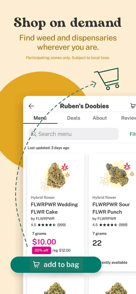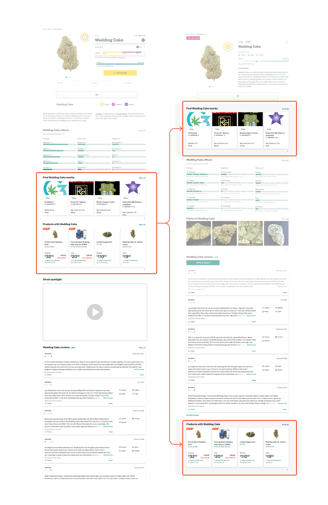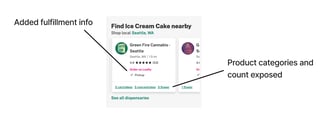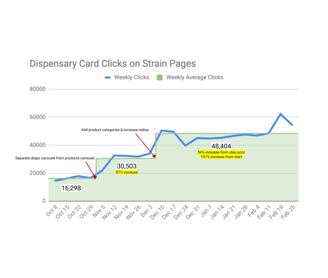Funnel Optimization
Strains to dispensary funnel optimization efforts and results.
OPTIMIZATIONUSER FEEDBACK


The results
As a Senior Product Manager at Leafly in October 2021, I took on the strategy and scope for converting Leafly's high-traffic strain page browsers to shoppers. The first focus was increasing traffic from strains to retailers.
Within our first 3 months, we implemented more than 30 changes to Leafly's strain pages and our efforts led to two significant increases: an 87% rise from October to November, followed by a 59% increase in mid-December.
By the end of December, the number of sessions from strains to retailers had tripled, resulting in a 197% increase from our starting point.
LEAFLY | October - December 2021
Background & the problem to solve
With over 5,000 strains in its database, Leafly is a leading cannabis resource millions of people rely on for reviews, lineage, and effect information.
Leafly has also built an online marketplace where licensed dispensaries (retailers) can post menus online, gain exposure across Leafly's user base, and accept pickup or delivery orders where available.
With over 1 million weekly visits to strain pages, it's a prime opportunity to optimize the funnel and figure out: how might we increase the flow of users from strain pages to retailers?






Goals & success metrics
What does success look like? And how will we measure it?





Identify levers and optimize funnel
Increase retail sessions
Incorporate new UX/UI patterns and components
Identify levers using user research and analyzing on-site behavior. Measure effectiveness of levers with Google Analytics events of retail card clicks that bring a user from a strain page to a menu.
Sessions are reported back to retailers as a way to measure ROI and set market prices that determine monthly subscription costs. An increase in sessions can mean an increase in revenue. Measured with Google Analytics session tracking.
Across the site, the UX/UI team was adding touches of our new brand elements. We were also leveraging re-usable front-end components to increase design consistency across the site. Success measured by Design team sign-off on progress.
FIRST CHANGE
Separating carousels
Hypothesis
If we rearrange elements of the page so that the dispensary carousel stands out more, we can increase volume of traffic to retailers.
Results
87% increase in clicks, gave validation to move forward with new layout
Dispensary carousel clicks were prioritized over product carousel ones due to product's lower click volume and CvR.



"The Boomerang Effect"
Using Google Analytics Funnel Reports, I identified an unusual pattern: most of the users we sent from strains to a retailer ended up returning to strains in the same session.
More than half (58%) of users return to strains after visiting a retailer.
The more retailers a user visits, the more likely they are to return to strains.
9% of users who visit a retailer from strains will visit five.
We hypothesized that this leaky funnel was due in part to users not seeing the strain in the form they want on the other side of the click.
User feedback consistently pointed to product category or form factor as key to a buying decision.
Add available product category count to cards
Aligned with new UI patterns
Included available product categories
Fulfillment method (pickup, delivery) and ordering exposed
SECOND CHANGE


Results
Ultimately, we raised the % of traffic going from strains to dispensaries from 3-4% to 5-6%
This resulted in 30,000 more dispensary sessions a week.


Lessons Learned & Next Steps
After these (and the other 30 'quick win' iterations) were released, we added surveys to the site and gathered feedback from more than 1,300 users on their Shopping Intent and Ordering Awareness.
These findings were incorporated in later iterations of the page that focused on leveraging these insights to increase order conversion.


Senior Product Manager
carainproduct@gmail.com
linkedin/cararizzo
